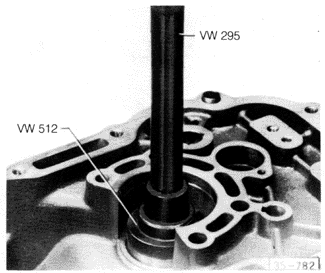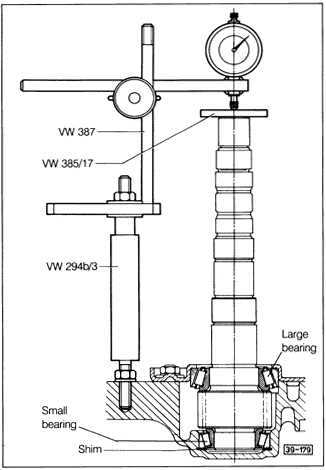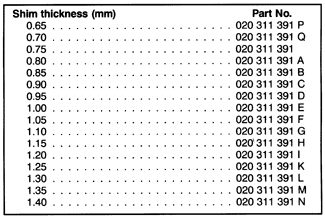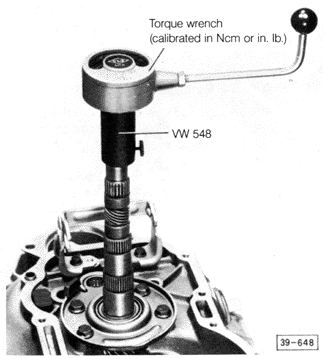Adjusting Pinion Shaft Bearings
The pinion shaft bearing preload must be adjusted if the gear carrier housing, the ring and pinion, or the pinion bearings are replaced. Adjust the pinion shaft with only the large and small pinion bearings installed on the shaft.
The procedures described here suggest or require the use of special tools. Unless otherwise specified, the numbers which appear in the illustrations identify Volkswagen special tools by their Volkswagen tool numbers.
To adjust:
| 1. | With the small pinion bearing outer race removed, place a 0.65 mm shim in the gear carrier housing and then press in the outer race as shown in Fig. 7-34. |
| Fig. 7-34. | Installing small pinion bearing outer race prior to adjustment. Temporary shim (0.65 mm) is installed between race and gear carrier housing to allow measurement of preload and calculation of correct shim thickness. |

|
| 2. | Temporarily install the pinion shaft and the large-bearing retaining plate, and torque the plate bolts to 40 Nm (30 ft. lb.). |
| 3. | Install a dial indicator as shown in Fig. 7-35 and set the dial to show 1 mm of preload. |
| Fig. 7-35. | Dial indicator set-up for testing pinion shaft bearing preload. |

|
| 4. | Move the pinion shaft up and down and note the amount of movement indicated by the dial indicator. The shim size needed to give the correct bearing preload is equal to the amount of movement, plus the thickness of the installed shim (0.65 mm), plus 0.20 mm. For example, if the pinion shaft moves up and down 0.30 mm, and the thickness of the installed shim is 0.65 mm, then the shim thickness needed for correct preload is 0.30 mm + 0.65 mm + 0.20 mm = 1.15 mm Table e lists the shims available to set the bearing clearance based on this calculation. |
CAUTION-
Do not turn the pinion shaft when measuring its movement. This will cause the bearings to settle and give an incorrect reading.
|
NOTE-
Parts numbers are for reference only. Always rely on an authorized Volkswagen parts department for the most accurate and up-to-date parts information.
|
Table e. Shims For Adjusting Pinion Shaft Bearing Preload

| 5. | Remove the pinion shaft, and then remove the small bearing outer race as shown above in Fig. 7-29. Remove the 0.65 shim and install the shim of the correct thickness (calculated in step 4). Reinstall the pinion shaft. |
| 6. | As a final check of bearing preload, lubricate the bearings with transmission oil and check the pinion shaft turning torque as shown in Fig. 7-36. Table f lists turning torque specifications. Torque that is too high indicates inadequate clearance, while torque that is too low indicates too much clearance. |
| Fig. 7-36. | Checking pinion shaft bearing preload by checking turning torque. Specifications are given in Table f. |

|
Table f. Pinion Shaft Bearing Turning Torque

|




